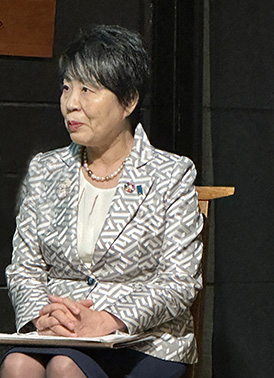Yoko Kamikawa
Chairman of the Japan Tea Export Promotion Council
On Thursday, March 23, 2023, I was invited to attend an informative and interesting lecture entitled, Japanese Tea – Innovation Beyond Tradition at the Japan Society in New York City. What I learned over the course of a few hours was fascinating.
Tea History and Types of Tea
Tea has a long and cherished history and tradition in Japanese culture that dates to 1,200 years ago, and the country produces twenty distinct types of tea. What makes the teas different is how they are processed after picking. Tea is grown in ten regions of Japan with different climates that produce teas with unique nuances. The main tea areas are Shizuoka, Kyoto, and Kagoshima, and tea leaves are harvested from April to May.
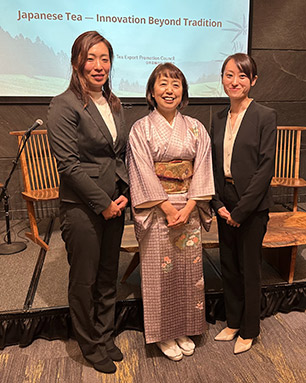
Asuka Kumada, Naomi Komatsu, Yuki Hoshino
Green tea is the primary tea grown in Japan. A sampling of the various teas includes Sencha, Houjicha, Matcha, Fukamushi Sencha, Genmaicha, and Japanese Black Tea. To create Matcha, they use an 800-year-old process of growing the leaves in shade. Each leaf is carefully picked, steamed, dried, and then ground into a powder. Green Tea is unoxidized and is steamed to stop the oxidation process, whereas Oolong and Black Tea are oxidized teas using the enzymes in the tea.
Fresh tea leaves (Namana) have approximately 80% water, which when processed will bring the water content down to 5%. The new leaves are steamed, and then twisted until soft and supple. At this point, the tea is referred to as unrefined tea (Aracha) and is shipped to auctions where it will be purchased by tea dealers who will complete the finishing of the tea.
The unrefined tea leaves are then passed through a sieve to divide them by length and to remove stems. This process will divide the tea into Sencha Large Leaves, Stems, Sencha Willow Leaves, and Powder. The leaves are then aligned by length using a cutting machine to align shapes.
After the primary processing of the unrefined raw ingredients, the tea is stored in a warehouse to protect against humidity, heat, light, and oxygen. Roasting is the final process, which will bring the water content down from 5% to 3% using precision temperature and care. The tea is then firmly packed to prevent oxidation and stored under strict temperature controls. When the tea dealers are ready to begin the finishing process, they will remove only the amount needed and finish the tea by blending (gogumi) it to create distinct flavors and aromas.
Steps from Beginning to the End
The tea is cultivated by farmers who also do primary processing to create Unrefined Tea (Aracha), which then goes to auction for purchase by Tea Dealers (Chasho) who will refine and process the tea. The finished tea is called Shiagecha, which is then sold by the Tea Dealers to the Consumer Market.
The Art of Tasting and Pairing
In addition to the lecture, guests were treated to a rare tea tasting and pairing of Japanese sweets called Wagashi. It was interesting to taste the unique qualities of each of the three teas and how they paired with food.
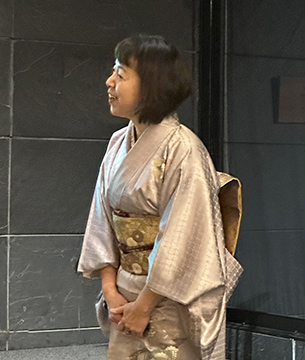
Naomi Komatsu
Naomi Komatsu, Senior Managing Director, KANES Co., Ltd. from Shizuola Prefecture spoke about her company and provided the first tea tasting of IBUKI Bottled Tea, a filtered cold brew, produced by KANES Co. Ltd. Made from a "rare variety of tea called "Kanaya Ibuki," which was developed over a 2-year period in their own research garden."
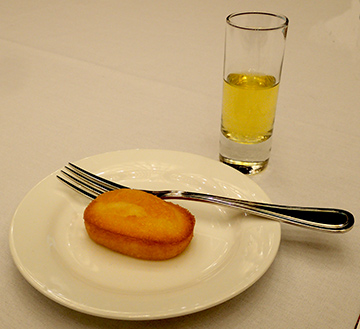
IBUKI
This tea was paired with a White Peach Financier, which was a rich and buttery cake that paired well with the IBUKI, to complement the mellow sweetness and robust flavor of the tea. IBUKI has layers of flavors like wine, and they recommend sipping it from a wine glass to fully appreciate its nuances and the sweet aftertaste. Although it was paired with a sweet cake, IBUKI also pairs well with rich, spicy food.
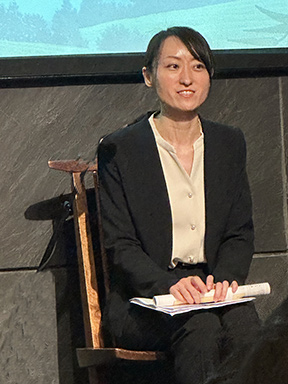
Yuki Hoshino
The next tea tasting, and company information was presented by Yuki Hoshino, Global Business Division, Kyoeiseicha Co, Ltd. from Kyoto Prefecture. This taste was ICE-BREW UJI GYOKURO. "Gyokuro" translates as "Jade Dew" is the masterpiece of Japanese Green Tea. The use of shade cultivation method gives the tea its rich, unique sweetness and "UMAMI" flavor.
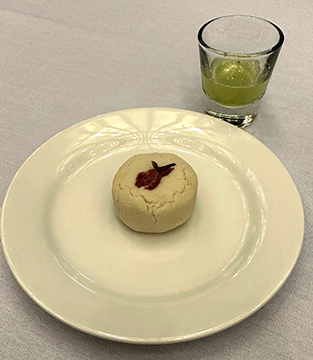
ICE-BREW UJI GYOKURO
To provide the most luxurious flavor, they placed ice on top of the Gyokuro leaves and allowed it to melt slowly over the leaves to give the tea its opulent mouthfeel and flavor. The food pairing was a seasonal Japanese Steamed cherry blossom flavored bean cake with a salted cherry blossom petal that celebrates the arrival of spring and cherry blossom season.
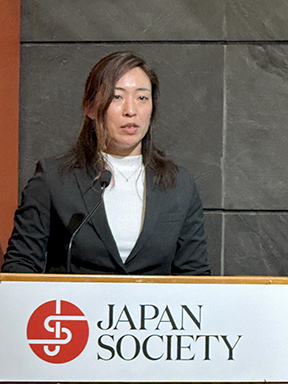
Asuka Kumada
The final tea tasting, and company information was presented by Asuka Kumada, Representative, KUMADA Co., Ltd. from Kagoshima Prefecture, who brought Japanese Black Tea, which is fermented tea. The Kumada family is well known for its organic sencha (non-fermented) green tea, however nine years ago they started to develop a hybrid organic black tea variety in smaller quantities called Benifuuki, to create a lower acid, fermented black tea without astringency. The result was a delicious, milder tea without the bitterness usually associated with black tea. Interesting to note about this tea is its "beneficial properties that have high levels of allergy-suppressing methylated catechins."
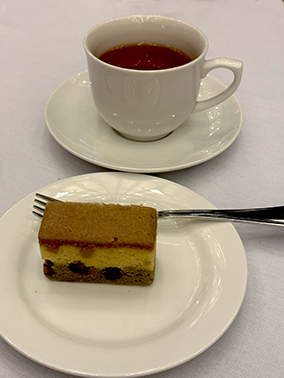
Benifuuki
The Benifuuki was beautifully paired with the confectionary Mainohana, a three-layered, steamed confectionary studded with chopped chestnuts and Dainagon kanoko beans.
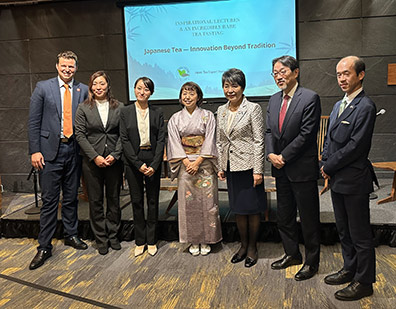
Panel
Panel Discussion
After the tasting, there was an informative panel discussion on the innovations in the Japanese tea industry. It was an afternoon of learning, tasting, and appreciating the history and culture of Japanese tea. Arigato gozaimasu! (Thank you).
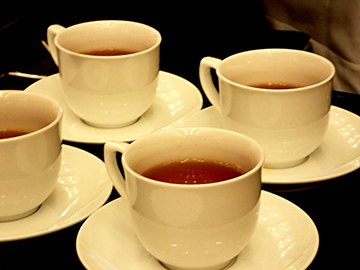
About Japan Society
"Japan Society is the premier organization connecting Japanese arts, culture, business, and society with audiences in New York and around the world. At Japan Society, we are inspired by the Japanese concept of kizuna forging deep connections to bind people together. We are committed to telling the story of Japan while strengthening connections within New York City and building new bridges beyond. In over 100 years of work, we’ve inspired generations by establishing ourselves as pioneers in supporting international exchanges in arts and culture, business, and policy, as well as education between Japan and the U.S. Now, more than ever, we strive to convene important conversations on topics that bind our two countries together, champion the next generation of innovative creators, promote mutual understanding, and serve as a trusted guide for people everywhere who seek to more fully appreciate the rich complexities and abundance of Japan. From our New York headquarters, a landmark building designed by architect Junzo Yoshimura that opened to the public in 1971, we look forward to the years ahead, which will be defined by our digital and ideational impact through the kizuna that we build. Our future can only be enhanced by learning from our peers and engaging with our audiences, both near and afar. Please join us."
For information on Japan Society and its upcoming events and programs, please visit the website: www.JapanSociety.com.
Japan Society
333 East 47th Street
New York, New York 10017
United States
Telephone: +1-212-715-1258
Website: www.japansociety.org
Facebook: www.facebook.com/japansociety
Instagram: www.instagram.com/japansociety
Follow Luxury Experience on Facebook: www.facebook.com/LuxuryExperience
Follow Luxury Experience on Twitter: www.twitter.com/luxurypair @luxurypair
Follow Luxury Experience on Instagram: www.Instagram.com/luxurypair @luxurypair
© April 2023. Luxury Experience. www.LuxuryExperience.com All rights reserved.

